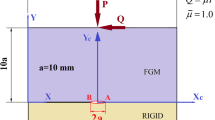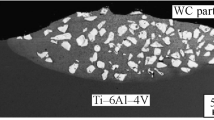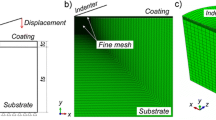Summary
Due to transient temperature change, the plane strain elastic-plastic problem for a functionally graded material (FGM) bonded to a homogeneous coating layer and a metal substrate is considered by the use of the finite element method (FEM). The substrate and the coating are assumed to be aluminum and partially stabilized zirconia, respectively. The FGM layer is a particulate composite of aluminum and partially stabilized zirconia with volume fractions continuously varying through the thickness. Generally in high temperature applications, the FGM system is sandwiched between a substrate layer and a coating layer. The coating layer increases the protection from heat but decreases the thermal shock resistance while the substrate layer increases the rigidity of the structure and decreases strength-related properties at high temperature. In order to compromise the thickness of both the coating and substrate layers, different values of the substrate and coating thickness are studied in order to evaluate their effects on the thermal stress response of the FGM structure. Since the main objective of the FGMs is using them in different applications with severe thermal loading conditions, the thermal stresses may be so high that some reinforcements may be fractured and/or debonded from the matrix giving a weakening effect instead of a reinforcing one. Hence, the behaviors of the reinforcements and the matrix are essential to be studied. In this regard, microscopic constitutive equations along with the temperature-dependent properties of the constituent materials are considered to enable us obtaining more realistic results of thermal stresses. Since the FGM structures are fabricated at high temperatures, thermal residual stresses are produced. In order to find out the importance of the consideration of the residual stresses arising from the fabrication process, the FGM structure with stress-free conditions is heated to the operating temperature, and its thermal stress response is compared with that one where the residual stresses are taken into account. Also, several functional forms of gradation of the constituents in the FGM layer are examined to reach the optimum profile giving the minimum stress level for the FGM structure under thermo-elasto-plastic behavior.
Similar content being viewed by others
References
Ravichandran, K. S.: Thermal residual stresses in a functionally graded material system. Mater. Sci. EngngA 201, 269–276 (1995).
Lee, Y-D., Erdogan, F.: Residual thermal stresses in FGM and laminated thermal barrier coatings. Int. J. Fract.69, 145–165 (1994/95).
Giannakopoulos, A. E., Olsson, M., Suresh, S., Finot, M.: Elastoplastic analysis of thermal cycling in layered materials with compositional gradients. Acta Metall. Mater.43, 1335–1354 (1995).
Kokini, K., Takeuchi, Y.: Multilayer ceramic thermal barrier coatings under transient thermal loads. The first Int. Symp. FGM (Yamanouchi, M., Koizumi, M., Hirai, T., Shiota, I., eds.), pp. 31–36. Senda 1990.
Kokini, K., Case, M.: Initiation of surface and interface edge cracks in functionally graded ceramic thermal barrier coatings. Trans. ASME119, 148–152 (1997).
Kokini, K., Choules, B. D.: Surface thermal fracture of functionally graded ceramic coatings: effects of architecture and materials. Comp. Engng5, 865–877 (1995).
Ueda, S.: Thermoelastic analysis of W-Cu functionally graded materials subjected to thermal shock using a micromechanical model. J. Thermal Stresses23, 19–46 (2000).
Dao, M., Gu, P., Maewal, A., Asaro, R. J.: A micromechanical study of residual stresses in functionally graded materials. Acta Mater.45, 3265–3276 (1997).
Suresh, S., Mortensen, A.: Functionally graded metals and metal-ceramic composites: Part 2: Thermomechanical behaviour. Int. Mat. Rev.42, 85–116 (1997).
Finot, M., Suresh, S., Glannakopoulos, A. E.: Sharp interfaces versus functionally graded metalceramic layers: geometrical optimization for mechanical response. 3rd Int. Symp. Structural and Functional Gradient Materials, pp. 223 (1994).
Ueda, S., Gasik, M.: Thermal-elasto-plastic analysis of W-Cu functionally graded materials subjected to a uniform heat flow by micromechanical model. J. Thermal Stresses23, 395–409 (2000).
Lee, Jae-M., Toi, Y.: Elasto-plastic damage analysis of functionally graded material disks subjected to thermal shock and thermal cycle. JSME, Ser.A 67 (655), 502–510 (2001–3) (in Japanese).
Itoh, Y., Takahashi, M., Okamura, T., Toyoda, M.: Thermal stress mitigating properties for graded thermal barrier coatings of gas turbine. JSME, Ser.A 61–583, 122–126 (1995–3) (in Japanese).
Asakawa, A., Noda, N., Tohgo, K., Tsuji, T.: Constitutional equations of thermal stresses of particle-reinforced composite. JSME, Ser.A 60–575, 1632–1637 (1994) (in Japanese).
Shabana, Y. M., Noda, N.: Thermo-elasto-plastic stresses in functionally graded materials taking the fabrication process into consideration. Arch. Appl. Mech.71, 649–660 (2001).
Noda, N., Nakai, S., Tsuji, T.: Thermal stresses in functionally graded material of particle-reinforced composite. JSME, Ser.A 41, 178–184 (1998).
Shabana, Y. M., Noda, N.: Thermoelasto-plastic stresses in functionally graded materials subjected to thermal loading taking residual stresses of the fabrication process into consideration. Composites, Part B: Engineering32, 111–121 (2001).
Shabana, Y. M., Noda, N.: Combined macroscopic and microscopic analysis of thermo-elastoplastic stresses of functionally graded material plate. J. Thermal Stresses24, 799–815 (2001).
Shabana, Y. M., Noda, N., Thogo, K.: Combined macroscopic and microscopic thermo-elastoplastic stresses of functionally graded plate considering fabrication process. JSME, Ser.A 44, 362–369 (2001).
Williamson, R. L., Rabin, B. H.: Numerical modeling of residual stress in Ni−Al2O3 gradient materials. In: The American Ceramic Society (Holt, J. B., Koizumi, M., Hirai, T., Munir, Z. A., eds.) Functionally Graded Materials, Ceramic Transactions34, pp. 55–65 (1993).
Tanigawa, Y., Kawamura, R., Oka, N., Akai, T.: Transient heat conduction and thermal stress problems of a nonhomogeneous plate with temperature-dependent material properties. J. Thermal Stresses19, 77–102 (1996).
Tanigawa, Y., Matsumoto, M., Akai, T.: Optimization of material composition to minimize thermal stresses in nonhomogeneous plate subject to unsteady heat supply. JSME, Ser.A 40, 84–93 (1997).
Noda, N., Tsuji, T.: Steady thermal stresses in a plate of functionally gradient material with temperature-dependent properties. JSME, Ser.A 57, 625–631 (1991) (in Japanese).
Author information
Authors and Affiliations
Rights and permissions
About this article
Cite this article
Shabana, Y.M., Noda, N. Geometry effects of substrate and coating layers on the thermal stress response of FGM structure. Acta Mechanica 159, 143–156 (2002). https://doi.org/10.1007/BF01171452
Received:
Issue Date:
DOI: https://doi.org/10.1007/BF01171452




